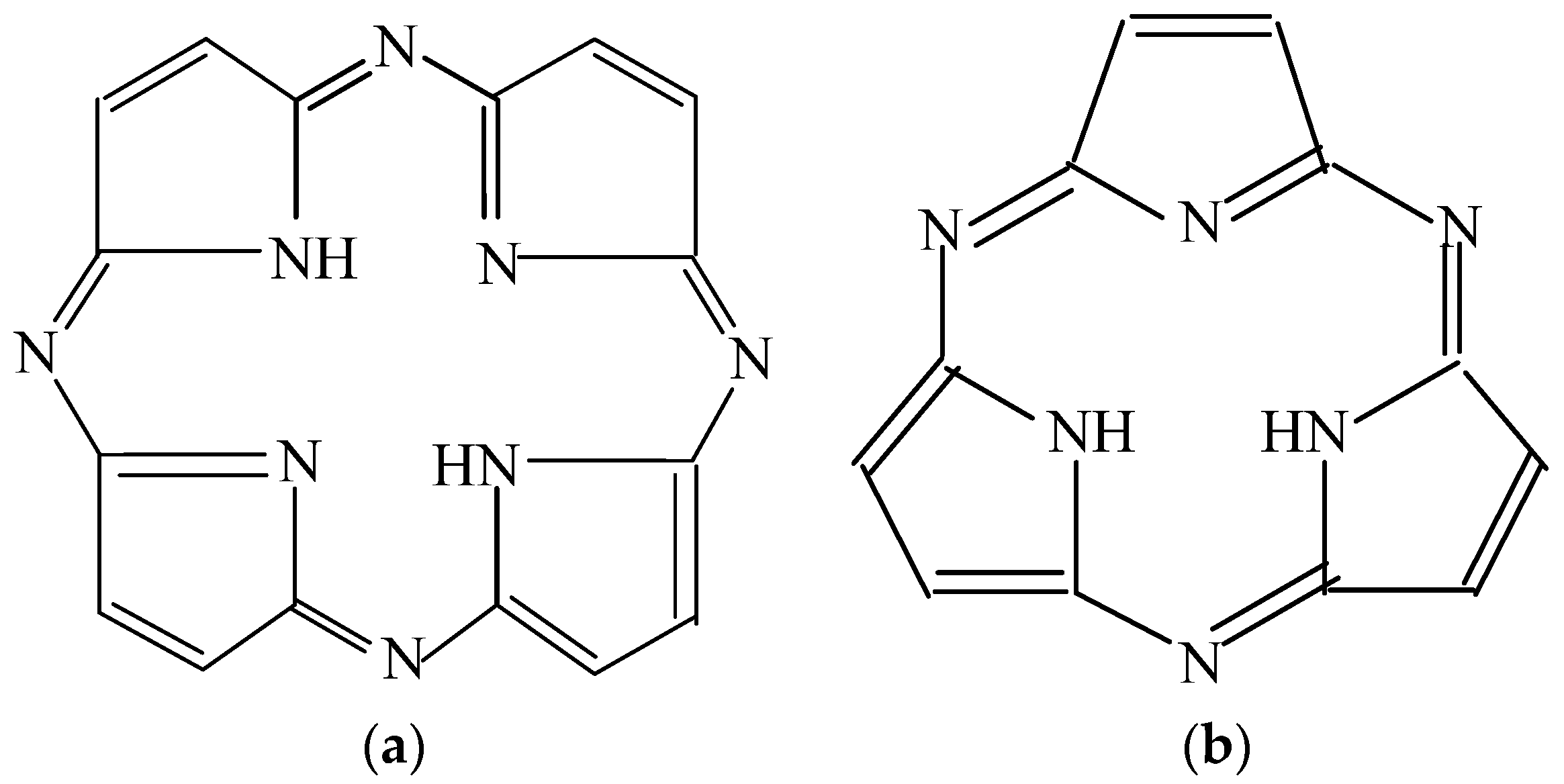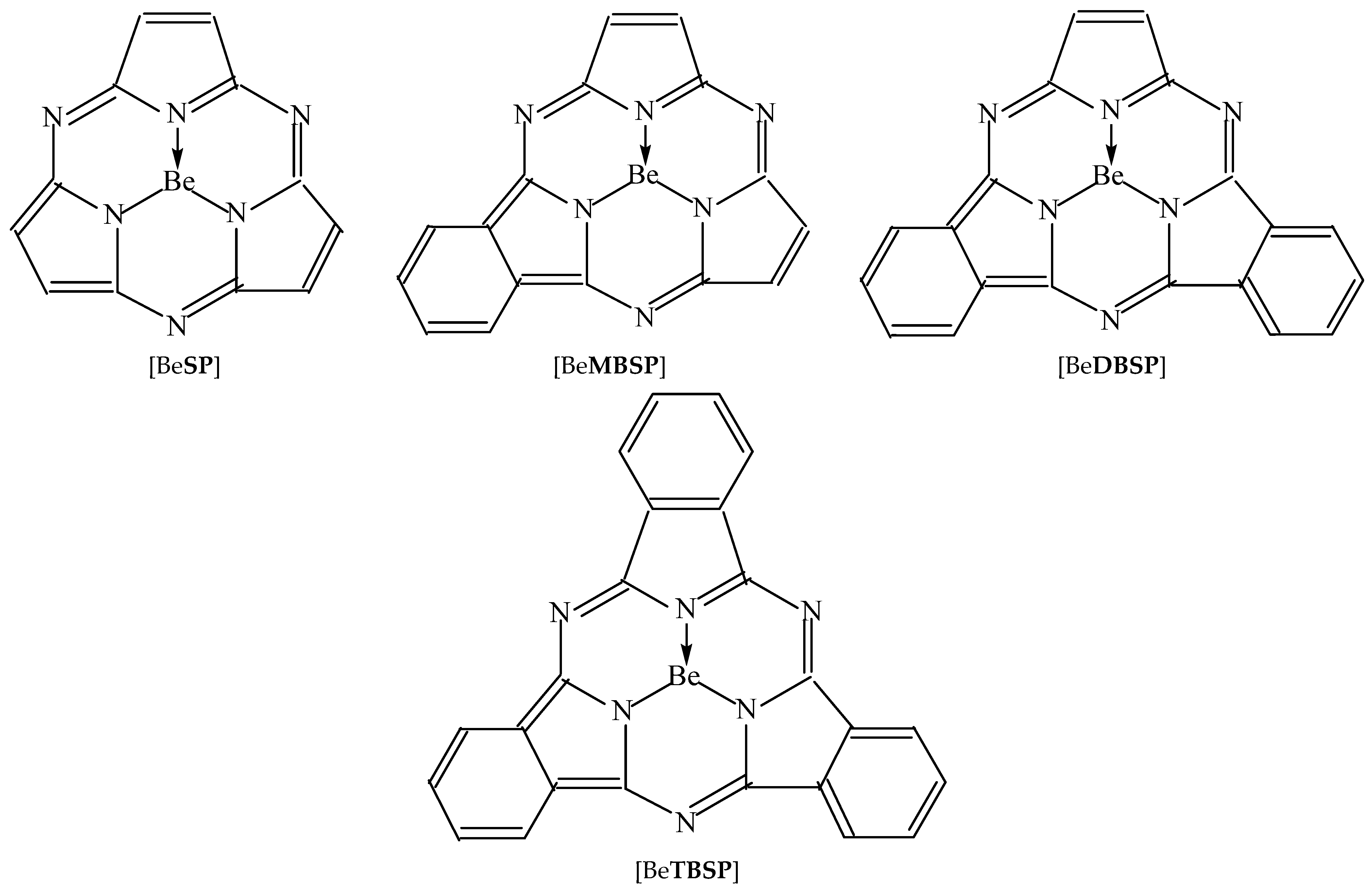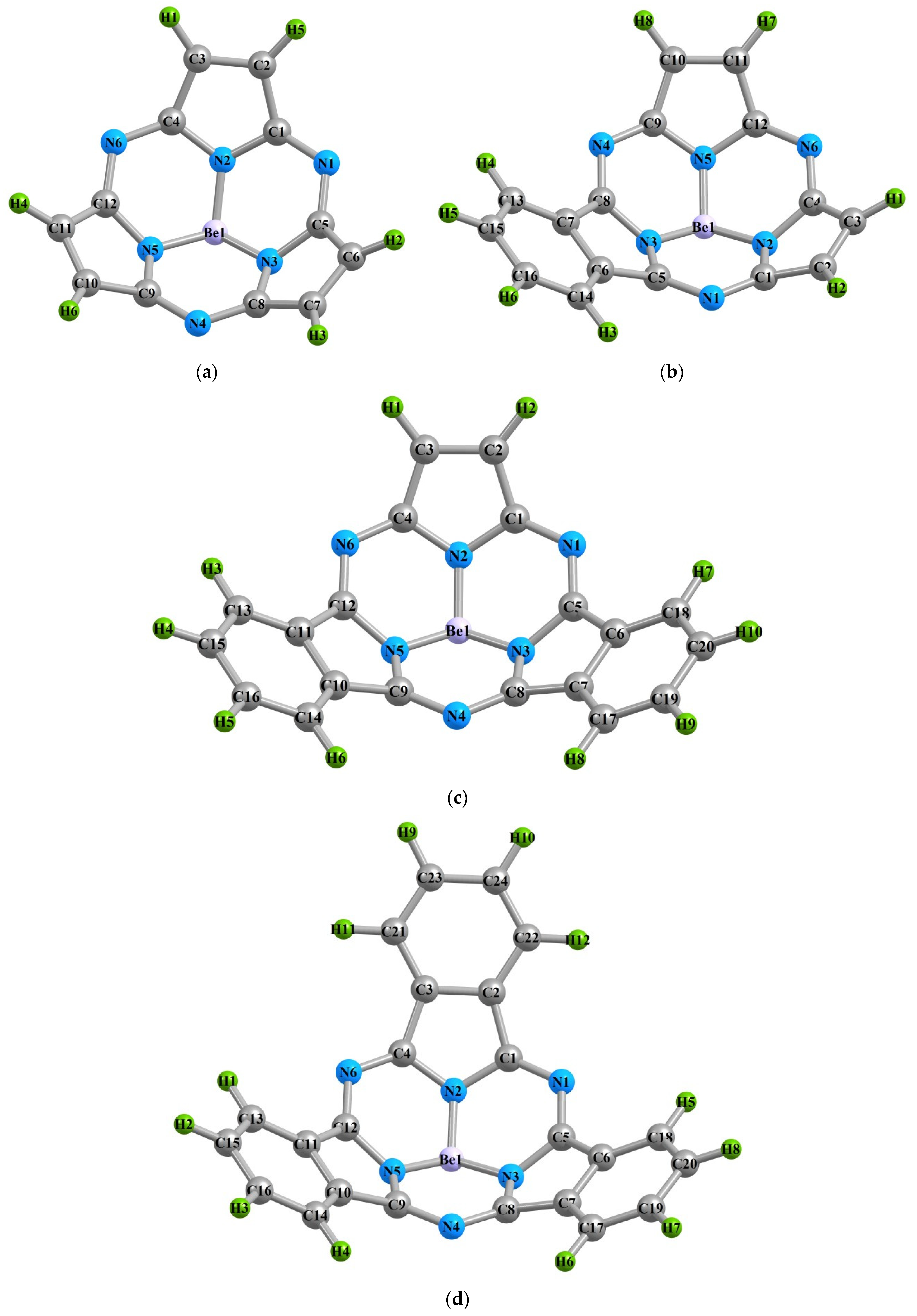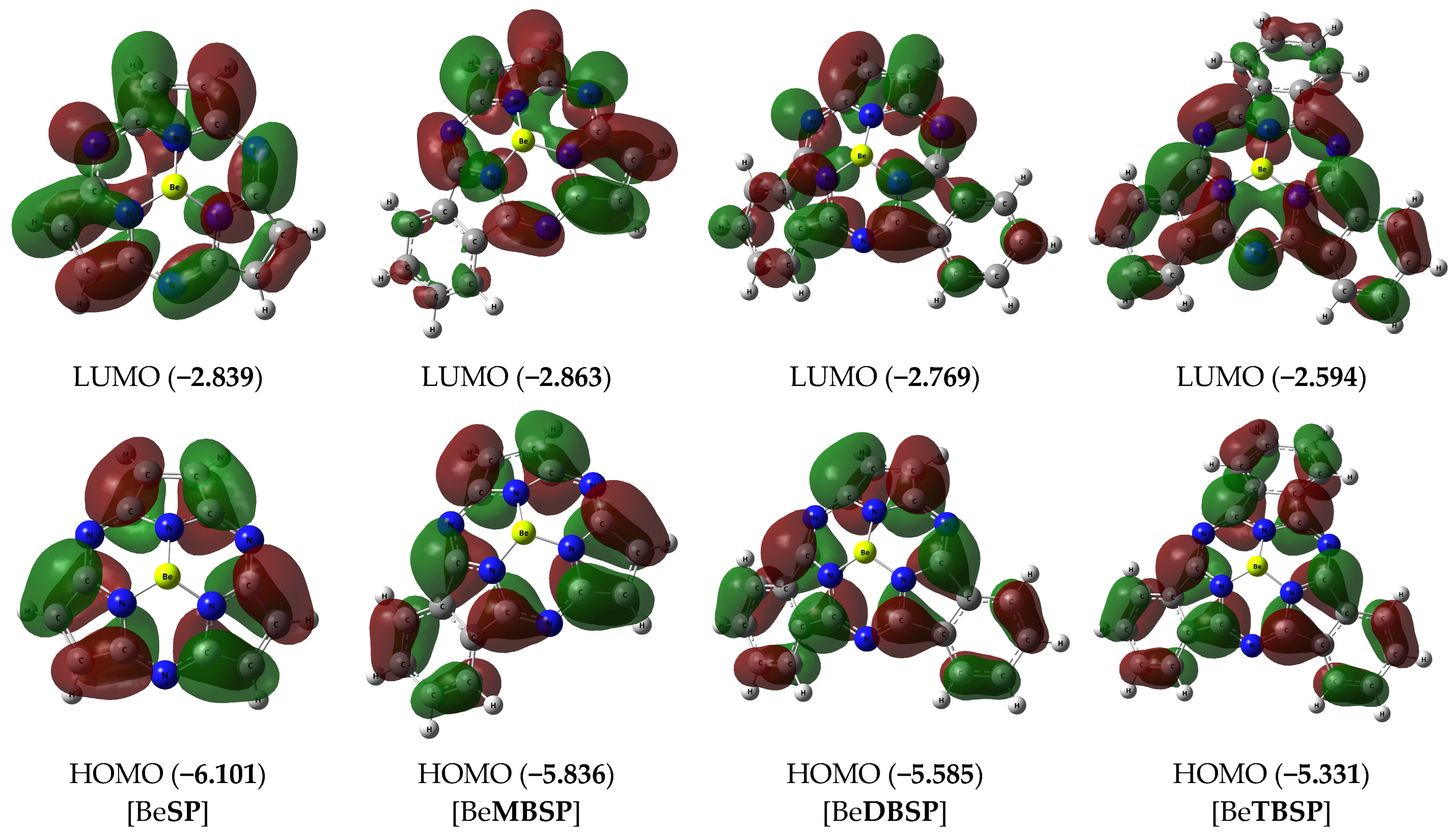First Examples of s-Metal Complexes with Subporphyrazine and Its Phenylene-Annulated Derivatives: DFT Calculations
Abstract
:1. Introduction
2. Results and Discussion
3. Method
4. Conclusions
Supplementary Materials
Author Contributions
Funding
Institutional Review Board Statement
Informed Consent Statement
Data Availability Statement
Acknowledgments
Conflicts of Interest
References
- Kasuda, K.; Tsutsui, M. Some new developments in the chemistry of metallophthalocyanines. Coord. Chem. Rev. 1980, 32, 67–95. [Google Scholar] [CrossRef]
- Sliva, W.; Mianovska, B. Metalloporphyrin arrays. Transit. Met. Chem. 2000, 25, 491–504. [Google Scholar] [CrossRef]
- Mamardashvili, G.M.; Mamardashvili, N.Z.; Koifman, O.I. Self-assembling systems based on porphyrins. Russ. Chem. Rev. 2008, 77, 59–75. [Google Scholar] [CrossRef]
- Khelevina, O.G.; Malyasova, A.S. 40 years with porphyrazines. J. Porphyr. Phthalocyanines 2019, 23, 1261–1264. [Google Scholar] [CrossRef]
- Thomas, A.L. Phthalocyanines. Research & Applications; CRC Press: Boca Raton, FL, USA, 1990; 304p. [Google Scholar]
- Lomova, T.N. Axial Coordinated Metal Porphyrins in Science and Practice; URSS: Moscow, Russia, 2018; 700p. [Google Scholar]
- Claessens, C.G.; González-Rodríguez, D.; Torres, T. Subphthalocyanines: Singular nonplanar aromatic compounds-synthesis, reactivity, and physical properties. Chem. Rev. 2002, 102, 835–853. [Google Scholar] [CrossRef] [PubMed]
- Salomé Rodríguez-Morgade, M.; Esperanza, S.; Torres, T.; Barberá, J. Synthesis, characterization, and properties of subporphyrazines: A new class of nonplanar, aromatic macrocycles with absorption in the green region. Chem.—A Eur. J. 2004, 11, 354–360. [Google Scholar] [CrossRef] [PubMed]
- Gommans, H.; Aernouts, T.; Verreet, B.; Heremans, P.; Medina, A.; Claessens, C.G.; Torres, T. Perfluorinated Subphthalocyanine as a New Acceptor Material in a Small-Molecule Bilayer Organic Solar Cell. Adv. Funct. Mater. 2009, 19, 3435–3439. [Google Scholar] [CrossRef]
- Morse, G.E.; Helander, M.G.; Maka, J.F.; Lu, Z.H.; Bender, T.P. Fluorinated phenoxy boron subphthalocyanines in organic light-emitting diodes. ACS Appl. Mater. Interfaces 2010, 2, 1934–1944. [Google Scholar] [CrossRef]
- Sullivan, P.; Duraud, A.; Hancox, L.; Beaumont, N.; Mirri, G.; Tucker, J.H.R.; Hatton, R.A.; Shipman, M.; Jones, T.S. Halogenated boron subphthalocyanines as light harvesting electron acceptors in organic photovoltaics. Adv. Energy Mater. 2011, 1, 352–355. [Google Scholar] [CrossRef]
- Beaumont, N.; Cho, S.W.; Sullivan, P.; Newby, D.; Smith, K.E.; Jones, T.S. Boron subphthalocyanine chloride as an electron acceptor for high-voltage fullerene-free organic photovoltaics. Adv. Funct. Mater. 2012, 22, 561–566. [Google Scholar] [CrossRef]
- Morse, G.E.; Bender, T.P. Boron subphthalocyanines as organic electronic materials. ACS Appl. Mater. Interfaces 2012, 4, 5055–5068. [Google Scholar] [CrossRef] [PubMed]
- Claessens, C.G.; González-Rodríguez, D.; Rodríguez-Morgade, M.S.; Medina, A.; Torres, T. Subphthalocyanines, Subporphyrazines, and Subporphyrins: Singular Nonplanar Aromatic Systems. Chem. Rev. 2014, 114, 2192–2277. [Google Scholar] [CrossRef] [PubMed]
- Dearden, C.A.; Walker, M.; Beaumont, N.; Hancox, I.; Unsworth, N.K.; Sullivan, P.; McConville, C.F.; Jones, T.S. High voltage hybrid organic photovoltaics using a zinc oxide acceptor and a subphthalocyanine donor. Phys. Chem. Chem. Phys. 2014, 16, 18896–18901. [Google Scholar] [CrossRef] [PubMed]
- Beaumont, N.; Castrucci, J.S.; Sullivan, P.; Morse, G.E.; Paton, A.S.; Lu, Z.H.; Bender, T.P.; Jones, T.S. Acceptor properties of boron subphthalocyanines in fullerene free photovoltaics. J. Phys. Chem. C 2014, 118, 14813–14823. [Google Scholar] [CrossRef]
- Ebenhoch, B.; Prasetya, N.B.A.; Rotello, V.M.; Cooke, G.; Samuel, I.D.W. Solution-processed boron subphthalocyanine derivatives as acceptors for organic bulk-heterojunction solar cells. J. Mater. Chem. A 2015, 3, 7345–7352. [Google Scholar] [CrossRef]
- Castrucci, J.S.; Josey, D.S.; Thibau, E.; Lu, Z.H.; Bender, T.P. Boron Subphthalocyanines as Triplet Harvesting Materials within Organic Photovoltaics. J. Phys. Chem. Lett. 2015, 6, 3121–3125. [Google Scholar] [CrossRef] [PubMed]
- Sfyri, G.; Kumar, C.V.; Sabapathi, G.; Giribabu, L.; Andrikopoulos, K.S.; Stathatos, E.; Lianos, P. Subphthalocyanine as hole transporting material for perovskite solar cells. RSC Adv. 2015, 5, 69813–69818. [Google Scholar] [CrossRef]
- Pakhomov, G.I.; Travkin, V.V.; Hamdoush, M.; Zhabanov, Y.A.; Stuzhin, P.A. Thiadiazole Fused Subporphyrazines as Acceptors in Organic Photovoltaic Cells. Macroheterocycles 2017, 10, 548–551. [Google Scholar] [CrossRef]
- Lee, H.; Ahn, S.W.; Ryu, S.H.; Ryu, B.K.; Lee, M.H.; Cho, S.W.; Smith, K.E.; Jones, T.S. Interfacial electronic structure of Cl6SubPc non-fullerene acceptors in organic photovoltaics using soft X-ray spectroscopies. Phys. Chem. Chem. Phys. 2017, 19, 31628–31633. [Google Scholar] [CrossRef] [PubMed]
- Stuzhin, P.A.; Skvortsov, I.A.; Zhabanov, Y.A.; Somov, N.V.; Razgonyaev, O.V.; Nikitin, I.A.; Koifman, O.I. Subphthalocyanine azaanalogues—Boron(III) subporphyrazines with fused pyrazine fragments. Dye. Pigment. 2019, 162, 888–897. [Google Scholar] [CrossRef]
- Hamdoush, M.; Nikitin, K.; Skvortsov, I.; Somov, N.; Zhabanov, Y.A.; Stuzhin, P.A. Influence of heteroatom substitution in benzene rings on structural features and spectral properties of subphthalocyanine dyes. Dye. Pigment. 2019, 170, 107584. [Google Scholar] [CrossRef]
- Mizrahi, A.; Bukuroshi, E.; Vestfrid, J.; Bender, T.P.; Gross, Z. Axial/Peripheral Chloride/Fluoride-Substituted Boron Subphthalocyanines as Electron Acceptors. Inorg. Chem. 2020, 59, 2641–2645. [Google Scholar] [CrossRef] [PubMed]
- Skvortsov, I.A.; Kovkova, U.P.; Zhabanov, Y.A.; Khodov, I.A.; Somov, N.V.; Pakhomov, G.L.; Stuzhin, P.A. Subphthalocyanine-type dye with enhanced electron affinity: Effect of combined azasubstitution and peripheral chlorination. Dye. Pigment. 2021, 185, 108944. [Google Scholar] [CrossRef]
- Mardirossian, N.; Head-Gordon, M. Thirty years of density functional theory in computational chemistry: An overview and extensive assessment of 200 density functionals. Mol. Phys. 2017, 115, 2315–2372. [Google Scholar] [CrossRef]
- Becke, A.D. Density-functional exchange-energy approximation with correct asymptotic behavior. Phys. Rev. A 1988, 38, 3098–3100. [Google Scholar] [CrossRef] [PubMed]
- Perdew, J.P.; Burke, K.; Wang, Y. Generalized gradient approximation for the exchange-correlation hole of a many-electron system. Phys. Rev. B 1996, 54, 16533–16539. [Google Scholar] [CrossRef] [PubMed]
- Medvedev, M.G.; Bushmarinov, I.S.; Sun, J.; Perdew, J.P.; Lyssenko, K.A. Density functional theory is straying from the path toward the exact functional. Science 2017, 355, 49–52. [Google Scholar] [CrossRef] [PubMed]
- Mikhailov, O.V.; Chachkov, D.V. DFT Quantum-Chemical Modeling Molecular Structures of Cobalt Macrocyclic Complexes with Porphyrazine or Its Benzo-Derivatives and Two Oxygen Acido Ligands. Int. J. Mol. Sci. 2020, 21, 9085. [Google Scholar] [CrossRef] [PubMed]
- Chachkov, D.V.; Mikhailov, O.V. Heteroligand Iron(V) Complexes Containing Porphyrazine, trans-Di[benzo]porphyrazine or Tetra[benzo]porphyrazine, Oxo and Fluoro Ligands: DFT Quantum-Chemical Study. Int. J. Mol. Sci. 2023, 24, 6442. [Google Scholar] [CrossRef] [PubMed]
- Mikhailov, O.V.; Chachkov, D.V. Molecular Structure of M(N13) Compounds with 12-Membered Nitrogen-Containing Cycle and Axial Nitrogen Atom (M = Mn, Fe): Quantum-Chemical Design by DFT Method. Quantum Rep. 2023, 5, 282–293. [Google Scholar] [CrossRef]
- Zhao, Y.; Truhlar, D.G. Comparative DFT study of van der Waals complexes: Rare-gas dimers, alkaline-earth dimers, zinc dimer, and zinc-rare-gas dimers. J. Phys. Chem. 2006, 110, 5121–5129. [Google Scholar] [CrossRef] [PubMed]
- Zhao, Y.; Truhlar, D.G. The M06 suite of density functionals for main group thermochemistry, thermochemical kinetics, noncovalent interactions, excited states, and transition elements: Two new functionals and systematic testing of four M06-class functionals and 12 other functionals. Theor. Chem. Acc. 2008, 120, 215–241. [Google Scholar] [CrossRef]
- Frisch, M.J.; Trucks, G.W.; Schlegel, H.B.; Scuseria, G.E.; Robb, M.A.; Cheeseman, J.R.; Scalmani, G.; Barone, V.; Mennucci, B.; Petersson, G.A.; et al. Gaussian 09, Revision A.01; Gaussian, Inc.: Wallingford, CT, USA, 2009. [Google Scholar]
- Weinhold, F.; Landis, C.R.; Glendening, E.D. What is NBO analysis and how is it useful? Int. Rev. Phys. Chem. 2016, 35, 399–440. [Google Scholar] [CrossRef]
- Ochterski, J.W. Thermochemistry in Gaussian; Gaussian, Inc.: Wallingford, CT, USA, 2000. [Google Scholar]




| Complex | [BeSP] | [BeMBSP] | [BeDBSP] | [BeTBSP] | ||||
|---|---|---|---|---|---|---|---|---|
| Structural Parameter | B3PW91/ TZVP | M062X/ def2TZVP | B3PW91/ TZVP | M062X/ def2TZVP | B3PW91/ TZVP | M062X/ def2TZVP | B3PW91/ TZVP | M062X/ def2TZVP |
| Be–N bond lengths in chelate node BeN3, pm | ||||||||
| Be1N2 | 153.7 | 153.8 | 153.5 | 153.6 | 153.2 | 153.2 | 153.5 | 153.7 |
| Be1N3 | 153.7 | 153.8 | 154.0 | 154.1 | 153.8 | 154.0 | 153.5 | 153.7 |
| Be1N5 | 153.7 | 153.8 | 153.5 | 153.6 | 153.8 | 154.0 | 153.5 | 153.7 |
| C–N bond lengths in 6-membered chelate rings, pm | ||||||||
| N1C1 | 134.1 | 133.9 | 135.1 | 135.5 | 135.3 | 136.0 | 133.8 | 133.7 |
| C1N2 | 136.6 | 136.2 | 136.1 | 135.4 | 136.7 | 136.3 | 136.6 | 136.2 |
| N2C4 | 136.6 | 136.2 | 137.3 | 137.2 | 136.7 | 136.3 | 136.6 | 136.2 |
| C4N6 | 134.1 | 133.9 | 134.0 | 133.8 | 135.3 | 136.0 | 133.8 | 133.7 |
| N6C12 | 134.1 | 133.9 | 134.0 | 133.8 | 132.6 | 131.6 | 133.8 | 133.7 |
| C12N5 | 136.6 | 136.2 | 137.3 | 137.2 | 137.5 | 137.8 | 136.6 | 136.2 |
| N5C9 | 136.6 | 136.2 | 136.1 | 135.4 | 135.9 | 135.0 | 136.6 | 136.2 |
| C9N4 | 134.1 | 133.9 | 135.1 | 135.5 | 134.0 | 133.9 | 133.8 | 133.7 |
| N4C8 | 134.1 | 133.9 | 132.9 | 132.4 | 134.0 | 133.9 | 133.8 | 133.7 |
| C8N3 | 136.6 | 136.2 | 136.7 | 136.4 | 135.9 | 135.0 | 136.6 | 136.2 |
| N3C5 | 136.6 | 136.2 | 136.7 | 136.4 | 137.5 | 137.8 | 136.6 | 136.2 |
| C5N1 | 134.1 | 133.9 | 132.9 | 132.4 | 132.6 | 131.6 | 133.8 | 133.7 |
| C–C bond lengths in 5-membered non-chelate rings (N2C1C2C3C4), pm | ||||||||
| C1C2 | 144.9 | 145.2 | 144.4 | 144.5 | 143.7 | 143.1 | 145.6 | 145.9 |
| C2C3 | 137.0 | 136.5 | 137.4 | 137.0 | 137.9 | 138.0 | 142.5 | 141.8 |
| C3C4 | 144.9 | 145.2 | 144.4 | 144.5 | 143.7 | 143.1 | 145.6 | 145.9 |
| C–C bond lengths in 5-membered non-chelate rings (N3C5C6C7C8), pm | ||||||||
| C5C6 | 144.9 | 145.2 | 146.4 | 147.0 | 146.2 | 146.7 | 145.6 | 145.9 |
| C6C7 | 137.0 | 136.5 | 142.1 | 141.3 | 142.2 | 141.4 | 142.5 | 141.8 |
| C7C8 | 144.9 | 145.2 | 146.4 | 147.0 | 146.1 | 146.6 | 145.6 | 145.9 |
| C–C bond lengths in 5-membered non-chelate rings (N5C9C10C11C12), pm | ||||||||
| C9C10 | 144.9 | 145.2 | 144.4 | 144.5 | 146.1 | 146.6 | 145.6 | 145.9 |
| C10C11 | 137.0 | 136.5 | 137.4 | 137.0 | 142.2 | 141.4 | 142.5 | 141.8 |
| C11C12 | 144.9 | 145.2 | 144.4 | 144.5 | 146.2 | 146.7 | 145.6 | 145.9 |
| Bond angles in BeN3 chelate node, deg | ||||||||
| N2Be1N5 | 110.8 | 110.2 | 111.5 | 111.0 | 111.3 | 110.8 | 111.0 | 110.3 |
| N5Be1N3 | 110.8 | 110.2 | 110.6 | 109.9 | 110.3 | 109.3 | 111.0 | 110.3 |
| N3Be1N2 | 110.8 | 110.2 | 110.6 | 109.9 | 111.3 | 110.8 | 111.0 | 110.3 |
| Bond angles sum (BAS), deg | 332.4 | 330.6 | 332.7 | 330.8 | 332.9 | 330.9 | 333.0 | 330.9 |
| Non-bond angles between N atoms in N3 grouping, deg | ||||||||
| N2N3N5 | 60.0 | 60.0 | 60.2 | 60.3 | 60.1 | 60.2 | 60.0 | 60.0 |
| N3N5N2 | 60.0 | 60.0 | 59.9 | 59.8 | 60.1 | 60.2 | 60.0 | 60.0 |
| N5N2N3 | 60.0 | 60.0 | 59.9 | 59.9 | 59.8 | 59.6 | 60.0 | 60.0 |
| Non-bond angles sum (NBAS), deg | 180.0 | 180.0 | 180.0 | 180.0 | 180.0 | 180.0 | 180.0 | 180.0 |
| Bond angles in the 6-membered chelate ring (Be1N2C1N1C5N3), deg | ||||||||
| Be1N2C1 | 119.9 | 120.1 | 120.1 | 120.5 | 119.8 | 120.2 | 119.7 | 120.0 |
| N2C1N1 | 123.8 | 123.8 | 123.6 | 123.5 | 123.2 | 122.9 | 123.5 | 123.5 |
| C1N1C5 | 120.1 | 120.0 | 120.1 | 119.8 | 120.9 | 120.9 | 120.9 | 120.7 |
| N1C5N3 | 123.8 | 123.8 | 124.0 | 124.2 | 123.7 | 123.8 | 123.5 | 123.5 |
| C5N3Be1 | 119.9 | 120.1 | 119.8 | 119.9 | 119.4 | 119.4 | 119.7 | 120.0 |
| N3Be1N2 | 110.8 | 110.2 | 110.6 | 109.9 | 111.3 | 110.8 | 111.0 | 110.3 |
| Bond angles sum (BAS61), deg | 718.3 | 718.0 | 718.2 | 717.8 | 717.9 | 718.0 | 718.3 | 718.0 |
| Bond angles in the 6-membered chelate ring (Be1N2C4N6C12N5), deg | ||||||||
| Be1N2C4 | 119.9 | 120.1 | 119.6 | 119.8 | 119.8 | 120.2 | 119.7 | 120.0 |
| N2C4N6 | 123.8 | 123.8 | 123.6 | 123.4 | 123.2 | 122.9 | 123.5 | 123.5 |
| C4N6C12 | 120.1 | 120.0 | 120.8 | 121.0 | 120.9 | 120.9 | 120.9 | 120.7 |
| N6C12N5 | 123.8 | 123.8 | 123.5 | 123.5 | 123.7 | 123.8 | 123.5 | 123.5 |
| C12N5Be1 | 119.9 | 120.1 | 119.6 | 119.8 | 119.4 | 119.4 | 119.7 | 120.0 |
| N5Be1N2 | 110.8 | 110.2 | 111.5 | 111.0 | 111.3 | 110.8 | 111.0 | 110.3 |
| Bond angles sum (BAS62), deg | 718.3 | 718.0 | 718.6 | 718.5 | 717.9 | 718.0 | 718.3 | 718.0 |
| Bond angles in the 6-membered chelate ring (Be1N5C9N4C8N3), deg | ||||||||
| Be1N5C9 | 119.9 | 120.1 | 120.1 | 120.5 | 120.1 | 120.4 | 119.7 | 120.0 |
| N5C9N4 | 123.8 | 123.8 | 123.6 | 123.5 | 123.8 | 124.2 | 123.5 | 123.5 |
| C9N4C8 | 120.1 | 120.0 | 120.1 | 119.8 | 120.0 | 119.3 | 120.9 | 120.7 |
| N4C8N3 | 123.8 | 123.8 | 124.0 | 124.2 | 123.8 | 124.2 | 123.5 | 123.5 |
| C8N3Be1 | 119.9 | 120.1 | 119.8 | 119.9 | 120.0 | 120.4 | 119.7 | 120.0 |
| N3Be1N5 | 110.8 | 110.2 | 110.6 | 109.9 | 110.3 | 109.4 | 111.0 | 110.3 |
| Bond angles sum (BAS63), deg | 718.3 | 718.0 | 718.2 | 717.8 | 718.0 | 717.9 | 718.3 | 718.0 |
| Bond angles in the 5-membered ring (N2C1C2C3C4), deg | ||||||||
| N2C1C2 | 106.4 | 106.4 | 106.7 | 106.8 | 106.5 | 106.7 | 105.7 | 105.7 |
| C1C2C3 | 107.4 | 107.4 | 107.4 | 107.3 | 107.4 | 107.4 | 106.9 | 106.9 |
| C2C3C4 | 107.4 | 107.4 | 107.5 | 107.5 | 107.4 | 107.4 | 106.9 | 106.9 |
| C3C4N2 | 106.4 | 106.4 | 106.2 | 106.2 | 106.5 | 106.7 | 105.7 | 105.7 |
| C4N2C1 | 109.9 | 110.1 | 110.0 | 110.1 | 110.1 | 110.2 | 112.5 | 112.5 |
| Bond angles sum (BAS51), deg | 537.5 | 537.7 | 537.8 | 537.9 | 537.9 | 538.4 | 537.7 | 537.7 |
| Bond angles in the 5-membered ring (N3C5C6C7C8), deg | ||||||||
| N3C5C6 | 106.4 | 106.4 | 105.6 | 105.6 | 105.4 | 105.2 | 105.7 | 105.7 |
| C5C6C7 | 107.4 | 107.4 | 106.8 | 106.8 | 106.9 | 106.9 | 106.9 | 106.9 |
| C6C7C8 | 107.4 | 107.4 | 106.8 | 106.8 | 106.9 | 106.8 | 106.9 | 106.9 |
| C7C8N3 | 106.4 | 106.4 | 105.6 | 105.6 | 105.9 | 106.1 | 105.7 | 105.7 |
| C8N3C5 | 109.9 | 110.1 | 112.2 | 112.2 | 112.3 | 112.3 | 112.5 | 112.5 |
| Bond angles sum (BAS52), deg | 537.5 | 537.7 | 537.0 | 537.0 | 537.4 | 537.3 | 537.7 | 537.7 |
| Bond angles in the 5-membered ring (N5C9C10C11C12), deg | ||||||||
| N5C9C10 | 106.4 | 106.4 | 106.7 | 106.8 | 105.9 | 106.1 | 105.7 | 105.7 |
| C9C10C11 | 107.4 | 107.4 | 107.4 | 107.3 | 106.9 | 106.8 | 106.9 | 106.9 |
| C10C11C12 | 107.4 | 107.4 | 107.5 | 107.5 | 106.9 | 106.9 | 106.9 | 106.9 |
| C11C12N5 | 106.4 | 106.4 | 106.2 | 106.2 | 105.4 | 105.2 | 105.7 | 105.7 |
| C12N5C9 | 109.9 | 110.1 | 110.0 | 110.1 | 112.3 | 112.3 | 112.5 | 112.5 |
| Bond angles sum (BAS53), deg | 537.5 | 537.7 | 537.8 | 537.9 | 537.4 | 537.3 | 537.7 | 537.7 |
| DFT Method Level | Complex | |||
|---|---|---|---|---|
| [BeSP] | [BeMBSP] | [BeDBSP] | [BeTBSP] | |
| DFT B3PW91/TZVP | 0.47 | 1.52 | 1.72 | 0.88 |
| DFT M062X/def2TZVP | 0.40 | 1.54 | 2.06 | 0.81 |
| Complex | DFT Method Level | Effective Charge on Atom, in Electron Charge Units (ē) | <S**2> | ||||||
|---|---|---|---|---|---|---|---|---|---|
| Be1 | N1 | N2 | N3 | N4 | N5 | N6 | |||
| [BeSP] | B3PW91/TZVP | +1.642 | −0.401 | −0.828 | −0.828 | −0.401 | −0.828 | −0.401 | 0.0000 |
| M062X/def2TZVP | +1.678 | −0.416 | −0.849 | −0.849 | −0.416 | −0.849 | −0.416 | 0.0000 | |
| [BeMBSP] | B3PW91/TZVP | +1.644 | −0.419 | −0.828 | −0.810 | −0.419 | −0.828 | −0.388 | 0.0000 |
| M062X/def2TZVP | +1.679 | −0.438 | −0.847 | −0.838 | −0.438 | −0.847 | −0.392 | 0.0000 | |
| [BeDBSP] | B3PW91/TZVP | +1.645 | −0.405 | −0.830 | −0.808 | −0.436 | −0.808 | −0.405 | 0.0000 |
| M062X/def2TZVP | +1.680 | −0.411 | −0.848 | −0.833 | −0.466 | −0.833 | −0.411 | 0.0000 | |
| [BeTBSP] | B3PW91/TZVP | +1.647 | −0.420 | −0.806 | −0.806 | −0.420 | −0.806 | −0.420 | 0.0000 |
| M062X/def2TZVP | +1.681 | −0.434 | −0.827 | −0.827 | −0.434 | −0.827 | −0.434 | 0.0000 | |
| Complex | ΔfH0, kJ/mol | S0, J/mol∙K | ΔfG0, kJ/mol |
|---|---|---|---|
| [BeSP] | 538.7 | 532.7 | 669.4 |
| [BeMBSP] | 565.8 | 624.2 | 708.1 |
| [BeDBSP] | 595.5 | 715.7 | 749.3 |
| [BeTBSP] | 629.2 | 807.3 | 794.6 |
Disclaimer/Publisher’s Note: The statements, opinions and data contained in all publications are solely those of the individual author(s) and contributor(s) and not of MDPI and/or the editor(s). MDPI and/or the editor(s) disclaim responsibility for any injury to people or property resulting from any ideas, methods, instructions or products referred to in the content. |
© 2024 by the authors. Licensee MDPI, Basel, Switzerland. This article is an open access article distributed under the terms and conditions of the Creative Commons Attribution (CC BY) license (https://creativecommons.org/licenses/by/4.0/).
Share and Cite
Chachkov, D.V.; Mikhailov, O.V.; Girichev, G.V. First Examples of s-Metal Complexes with Subporphyrazine and Its Phenylene-Annulated Derivatives: DFT Calculations. Int. J. Mol. Sci. 2024, 25, 6897. https://doi.org/10.3390/ijms25136897
Chachkov DV, Mikhailov OV, Girichev GV. First Examples of s-Metal Complexes with Subporphyrazine and Its Phenylene-Annulated Derivatives: DFT Calculations. International Journal of Molecular Sciences. 2024; 25(13):6897. https://doi.org/10.3390/ijms25136897
Chicago/Turabian StyleChachkov, Denis V., Oleg V. Mikhailov, and Georgiy V. Girichev. 2024. "First Examples of s-Metal Complexes with Subporphyrazine and Its Phenylene-Annulated Derivatives: DFT Calculations" International Journal of Molecular Sciences 25, no. 13: 6897. https://doi.org/10.3390/ijms25136897






